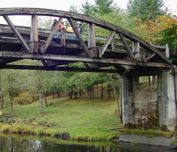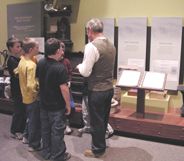Public Lands: America's Largest ClassroomAre you looking for new ways to increase your students' interest and achievement in science, mathematics, and reading? Is student motivation suffering in your classroom? Why not consider taking your teaching outside? Studies have shown that using the environment as a learning tool not only increases student achievement but also helps students develop lifelong learning skills and a greater sense of respect and responsibility. If this approach sounds intriguing, consider the Hands on the Land program, which gives students an opportunity to learn in America's largest field classroom—Federally owned public lands. BLM's 258 million acres host a growing number of Hands on the Land sites, where education programs have been developed in conjunction with local schools. Learn more about the opportunities provided at each site by clicking on the links below.
For more information on the Hands on the Land program, visit http://www.handsontheland.org
 | Alaska — Campbell Creek Science Center
Located on BLM's Campbell Tract in downtown Anchorage, the Campbell Creek Science Center is surrounded by aspen forests, rippling creeks, and a network of trails. Interactive, standards-based outdoor programs help students discover the wonders of nature in their own backyard. |  | Arizona — Empire Ranch
Part of the Las Cienegas National Conservation Area southeast of Tucson, the Empire Ranch reflects and preserves the story of ranch life from the frontier era to modern times. Education programs focus on the ecology of the surrounding rangeland, anthropology, and local history. | | | Arizona — Metro Tech Wildland Fire Training Course
BLM wildland firefighters partner with a Phoenix-area vocational high school to provide a wildland fire curriculum that includes not only traditional classroom instruction but also practical experience outdoors in diverse fire drills and exercises, along with basic physical training and hands-on learning. | | | California — Atwell Island
Located in the Central Valley near Alpaugh, Atwell Island is a landscape in transition—with land managers working to restore native valley grassland and alkali sink habitats on an area that for the past century was covered by vast fields of cotton, oats, and alfalfa. By growing native plants in a greenhouse, students are participating in the restoration and also engaging in hands-on science and service learning. | | | California — Big Morongo Canyon Preserve
This desert canyon oasis, some 15 miles north of Palm Springs, provides habitat for wildlife and numerous species of birds. Programs for students, based on local school district requirements, are usually conducted on one of six trails and cover a wide variety of topics—from biology and ecology, to geology and the weather. | | | California — Cosumnes River Preserve
Located some 20 miles south of Sacramento, the 40,000-acre preserve is home to California’s largest remaining valley oak riparian forest. Students from the surrounding school districts are actively involved in habitat restoration projects and in other field experiences that complement classroom studies. Teacher workshops are also offered. |  | California — Desert Discovery Center
A unique partnership among government agencies, schools, community groups, and the Discovery Trails Corporation has led to the creation of environment-based education programs for K-12 students at the Desert Discovery Center in Barstow. State standards have guided the development of programs on wildlife, botany, geology, history, cultural resources, and stewardship. |  | California — Fish Slough
This Area of Critical Environmental Concern is a unique desert wetland ecosystem located only a mile north of Bishop, California. Fish Slough has served as a field classroom for local schools for nearly 20 years, offering a variety of hands-on education programs focusing on biology, geology, and archaeology. Community volunteers and numerous other partners play an active role in the development and presentation of these programs. |  | California — Headwaters Forest Reserve
Considered the last unprotected large stand of old-growth redwood forest, the 7,400-acre Headwaters Forest Reserve is located near the town of Arcata in northern California. Education programs focus on the botanical diversity of the area, the habitat needs of plants and animals, and the historic mill town of Falk . | | | California — King Range National Conservation Area
Located near Arcata, the King Range region, known as the Lost Coast, is one of the most rugged and remote stretches of coastline in the continental U.S. Habitat types range from mixed evergreen and coniferous forests, and chaparral to coastal scrub, dunes, and prairies. Educational programs focus on the Mattole River watershed, as well as fire ecology and invasive non-native plants. Service learning projects include tree planting, invasive plant removal, and trail building. |  | California — San Joaquin River Gorge
Some 40 miles from Fresno, this BLM site along one of California's largest rivers provides the setting for a wide array of education programs focusing not only on the long cultural history of the area but on the diverse natural resources of this transition zone between the Sierra Nevada and the Central Valley. |  | California — Sand Canyon Environmental Education Program
Located in the Sierra Nevada Mountains near Ridgecrest, Sand Canyon offers students an opportunity to learn how animals and humans adapt to life in a fragile desert environment. Community partners play a major role in providing instruction in the field as well as at pre- and post- sessions in the classroom. |  | California — Santa Rosa and San Jacinto Mountains National Monument
Numerous partners in the Palm Springs area contribute to the dynamic outdoor study program at this National Monument. Based on California State Standards, lessons include both a classroom visit and a field trip focusing on such topics as ecology of the palm oasis, plant and animal adaptations, rock identification and erosion processes, as well as safety tips and Leave No Trace ethics for outdoor recreation. |  | Colorado — Blanca Wetlands, San Luis Valley Public Lands Center
Part of a Service First HOL site, BLM's Blanca Wetlands are but one component of a larger San Luis Valley environmental education strategy designed to foster greater awareness among students, parents, and teachers. More than 200 ponds located in the arid San Luis Valley of southern Colorado offer countless opportunities for hands-on/minds-on lessons for students from kindergarten through high school.
|  | Colorado — Garden Park Fossil Area
Fascination for dinosaurs can propel many young people to a lifelong interest in science, and at Garden Park Fossil Area, near Canon City, students have the opportunity to visit historic fossil quarries. Fossils can provide the "raw materials" for teaching about structure and function in animals, changes over time, and scientific inquiry. |  | Florida — Jupiter Inlet Outstanding Natural Area
This BLM Outstanding Natural Area near Jupiter Lighthouse on Florida's east coast provides students with many opportunities for hands-on learning. High school students have designed projects related to tidal wetlands, lagoon fisheries, and prescribed fire. | | | Idaho — Challis Outdoor Classroom
An area rich in Native American and mining history, public lands near Challis are also well-suited to studies of riparian, aquatic, and range ecology; hydrology; fisheries; and botany. High-school students monitor plots and introduce younger students to data collection techniques and the results of their studies. |  | Idaho — Craters of the Moon
A volcanic sea on central Idaho's Snake River Plain, Craters of the Moon offers students an opportunity to learn about the region's fascinating and turbulent geologic history. In addition to field trips—"to the moon without leaving Idaho"—curriculum guides, rock specimens, and reference materials are made available to local schools. |  | Idaho — F.I.R.E. Up for Summer
A partnership among BLM, a local university, and the Meridian school district provides middle and secondary students with a Field Inquiry Research Experience (F.I.R.E.) during three weeks each summer. Students learn to use GPS units, radios, digital cameras, and computer software, which enables them to inventory fire hazards, collect data in post-burn areas, and conduct other fire-related research needed on Idaho public lands. |  | Montana — Upper Missouri River Breaks National Monument
With an interpretive center that opened in 2006, the Upper Missouri River Breaks National Monument is actively working with the Fort Benton School District and other partners to link the classroom curriculum with outdoor education experiences in history, geology, biology, and other subjects. |  | Nevada — Red Rock Canyon National Conservation Area
Three different desert ecosystems—the Mojave, the Colorado Plateau, and the Great Basin—meet in this BLM Conservation Area, located less than 20 miles from Las Vegas. Students from one of the fastest-growing communities in the nation learn about desert and riparian ecosystems and the variety of biological communities inhabiting them. |  | Oregon — Alder Creek Children's Forest
Nearly 300 acres of forested land in the Alder-Jordan Creek watershed serve as a living laboratory for terrestrial and aquatic inventory projects undertaken by students in the Roseburg area. |  | Oregon — McGregor Park
Located 30 miles northeast of Medford, McGregor Park is a lush riparian park with a web of trails and stations developed for environmental education. Program participants are able to witness salmon spawning in the river 5 feet away from them, can view a beaver lodge and beaver activity, are able to enjoy great blue herons, ospreys and bald eagles flying overhead, and are immersed in the rich natural history of the Upper Rogue River. |  | Oregon — Roseburg/Glide Middle School Partnership
Since 1996, BLM, the U.S. Forest Service, and 8th graders from Glide Middle School have been working together to collect water quality data at five sites in the Little River Watershed. Hydrologists and Geographic Information System (GIS) specialists train students in the use of monitoring equipment and help teachers develop classroom exercises based on the data students gather. |  | Oregon — Table Rocks
Upper and Lower Table Rocks are two mesa buttes near Medford that provide amazing vistas of surrounding mountains. Education programs focus on geology, fire ecology, Native American history and culture, forest management, botany, noxious weeds, general ecology, wildlife biology, and more. Offerings include guided, interpretive hikes, as well as pre-hike, preparatory classroom presentations, an educational website, activity kits, and accompanying curriculum. |  | Oregon — West Eugene Wetlands
Located within the city limits of Eugene, Oregon, the West Eugene Wetlands contain one of the most endangered plant communities in the nation—the Willamette River wet prairie. The Willamette Resources and Educational Network, in collaboration with government agencies and non-profit organizations, is utilizing the wetlands and nearby upland areas as living laboratories for the study of migratory birds, soils, watersheds, plants, food chains, insects, and other topics. |  | Oregon — Wildwood Recreation Site
Aquatic ecosystems are the focus of study at this site on the Salmon River near Portland. Teams of students investigate the chemical, physical, and biological characteristics of the water, learning lessons in ecological relationships and stewardship. |  | Virginia — Meadowood
Located some 20 miles south of Washington, D.C., 500 acres of open space provide habitat for birds and other wildlife as well as an outdoor classroom for plant and animal monitoring, comparison studies, and water quality testing. |  | Wyoming — National Historic Trails Interpretive Center
The National Historic Trails Interpretive Center in Casper opened in 2002 and has already hosted thousands of students. The focus of educational programs has been on the significance of the four nationally designated historic trails that pass through Wyoming. Enthusiastic educators and partners are working with BLM staff to expand programs to include science and stewardship at sites along the nearby North Platte River. | | |
Washington — San Juan Islands
The San Juan Islands Outdoor Experiential Education Classroom offers a wide and diverse array of outdoor learning opportunities. From natural world explorations, inter-tidal marine community interface, and marine history and culture, participants are able to reconnect with their local environment. Programs are predominantly for middle school students during the local school year, but special learning events are held throughout the year for students of all ages as well as adults.
|
|